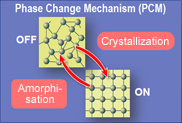The phase change effect (PC) found particularly in tellurides such as “GeSbTe” or “AgInSbTe” as well as some selenides involves a high-resistive amorphous phase and a low-resistive crystalline phase. The high-resistive state (HRS) is established by local melting and quenching the alloy by a short, strong current pulse. This results in an amorphous bit. The subsequent transition to the low-resistive state (LRS) is achieved by applying a longer current pulse to crystallize filaments in the material between the two electrodes. The switching process to the crystalline phase is facilitated by high intrinsic concentrations of electronically active defects which allow for a Poole-Frenkel type conduction and a threshold switching as a prerequisite of the phase transformation. The phase change is accompanied by local rearrangements of the atoms as well as changes of the electron densities in the bonds.

